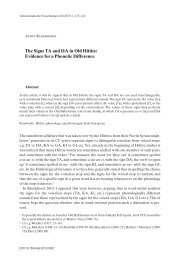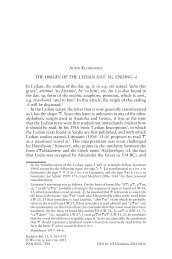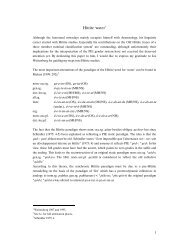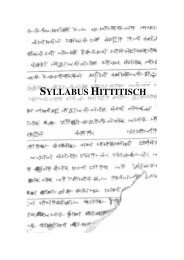Indo-European Nominal Ablaut Patterns - Alwin Kloekhorst ...
Indo-European Nominal Ablaut Patterns - Alwin Kloekhorst ...
Indo-European Nominal Ablaut Patterns - Alwin Kloekhorst ...
Create successful ePaper yourself
Turn your PDF publications into a flip-book with our unique Google optimized e-Paper software.
the suffix shows zero grade next to a stem in which the root shows zero-grade but the suffix contains a<br />
full grade. This combination of stems is inexplicable within the Erlangen model. The only way in<br />
which it can be accounted for, is by reconstructing a hysterodynamic paradigm according to the<br />
Leiden model: 25<br />
nom.sg. *h1ér-h2<br />
acc.sg. *h1r-éh2-m<br />
gen.sg. *h1r-h2-és<br />
(6) Connection between Leiden ‘hysterodynamic’ and Erlangen ‘hysterokinetic’<br />
The pattern that in the Erlangen model is called hysterokinetic is reconstructed with the following<br />
forms:<br />
nom.sg. *CC-ḗC e.g. *ph2-tḗr ‘father’<br />
acc.sg. *CC-éC-m *ph2-tér-m<br />
gen.sg. *CC-C-és *ph2-tr-és<br />
As we see, the acc.sg. and gen.sg. forms are identical to the forms in the Leiden hysterodynamic<br />
paradigm. Only the nominative form is different. Beekes (1985: 154) therefore assumes that there is a<br />
close connection between the hysterodynamic paradigm and the hysterokinetic one. According to him,<br />
the hysterodynamic paradigm, containing the nom.sg. form *CéC-C, is original, whereas the<br />
hysterokinetic paradigm, containing the nom.sg. form *CC-ḗC, is a younger off-shoot of it. 26 The idea<br />
is that in the original hysterodynamic paradigm the accusative stem secondarily spread to the<br />
nominative case (with subsequent lengthening of *e to *ē when standing before a word-final resonant,<br />
cf. section 8).<br />
nom.sg. *CéC-C >> *CC-ḗC<br />
acc.sg. *CC-éC-m = *CC-éC-m<br />
gen.sg. *CC-C-és = *CC-C-és<br />
It must be stressed that this scenario involves only one trivial assumption, namely influence of the<br />
accusative stem on the nominative stem, which is a process that can be observed in many languages<br />
over and over again.<br />
This scenario implies that the hysterokinetic nom.sg. *CC-ḗC always is a younger version of original<br />
*CéC-C. For e.g. *ph2tḗr ‘father’, this means that there must have been an original nom.sg. form<br />
*péh2-tr, which according to Kortlandt (2009: 7) is identical to the verbal noun *péh2-tr as attested in<br />
Skt. pātár- ‘protector’. 27 For e.g. *d h uǵh2tḗr ‘daughter’, I have already argued on other grounds that<br />
the original nom.sg. form must have been *d h uéǵh2-tr. 28 For e.g. *h2stḗr ‘star’, Pinault (2007: 273)<br />
posits a nom.sg. *h2éh1s-tr, 29 a verbal noun to the root *h2eh1s- “to burn, glow” (which implies that<br />
‘star’ actually is *h2h1stḗr).<br />
(7) Hysterokinetic in Anatolian<br />
In Anatolian, we find some traces of hysterokinetic paradigms as well, although not all details are<br />
always clear. The best example is the word for ‘star’:<br />
nom.sg. ḫašterza < *h2s-tḗr(+s) ‘star’<br />
25<br />
Cf. <strong>Kloekhorst</strong> 2008: 247 for the reconstruction of this paradigm.<br />
26<br />
In Beekes 1995: 175, the hysterokinetic paradigm is therefore called ‘subtype 1’ of the hysterodynamic<br />
inflection.<br />
27<br />
Cf. footnote 35 for a detailed discussion of the connection between ‘protector’ and ‘father’.<br />
28 h<br />
Cf. <strong>Kloekhorst</strong> fthc.b where I argue that a stem *d uéǵh2-tr-, i.e. with full grade in the root, is reflected in the<br />
Anatolian words for ‘daughter’, HLuw. tuwatra/i-, Lyc. kbatra- < Proto-Luwic *tuatra- < *d h ueǵh2-tr-eh2-.<br />
29<br />
Pinault’s scenario to explain the hysterokinetic paradigm *h2stḗr, etc. differs from the one presented here,<br />
however.<br />
6






